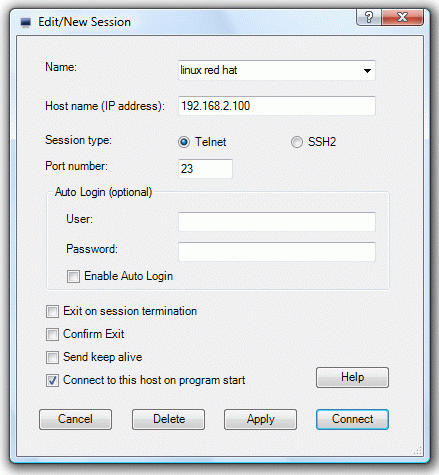Mocha Telnet Help
Making a session
There are three ways you can use to connect to a remote machine:If no session has previous been configured, and connect is selected the normal connect dialog is shown:
- select the connect icon in the tool bar

- use menu - file - connect or edit/new session
- give the IP address for the host as a parameter to the program

- Name: A session can be given any name, which will make it easier to remember it. The session name is also shown in the title bar when the session is active
- Host name: Name of the host. Either a TCP/IP address as 155.22.11.2 or a DNS name.
- Session type: Either Telnet or SSH-2 (Secure Shell)
- Port number:Port number for the session. As default Telnet uses port 23 and SSH port 22
- Auto Login: User and Password for the user login on the host. Having these informations in this dialog gives less security.
- Exit on session termination:If the UNIX host terminates the session, Mocha Telnet will close without any notification.
- Confirm exit:If mocha Telnet is terminated (maybe with ALT F4), and a session is active, an exit confirm box will be shown.
- Send keep alive:The TCP layer is designed to keep the connection alive, but with network problems, this option can be used to send extra keep alive packets with 10 second intervals.
- Connect to this host at program start: If enabled, a session will be started, when the program is loaded.
Using the mouse
There are 2 ways to select text in the screen:- move the mouse pointer over an area of the screen, while holding down the left mouse button
- put the mouse cursor over a word and double-clicking on the word with the left mouse button.
Hereafter use function copy to copy the text data to the clipboard.
If Ctrl+C is not used in the UNIX application, select menu - edit - ctrl c+v as copy paste , as to make it possible to use Ctrl+C for easy access for the Copy function.
Scrolling
A real VT220 terminal has no scroll function. Mocha Telnet includes a vertical scroll bar, which can be used to look back in data, which has scrolled away from the current view. Not all UNIX applications can be used with scroll, but if listing files with a ls -l function, it can be useful.If a mouse with scroll wheel is used, the wheel can be used to scroll the buffer.
Changing font size
The screen font size follows the size of the window. The program will always try to use the largest possible font size. If a larger font is wanted, use the mouse to pull the current Telnet window to a larger size.The font size for printing can be defined in
menu - Tools - Options - printer
Configuration files
The configuration, including the keyboard layout is stored in a single file user.config (XML format). The file location can be viewed inmenu - Tools - Options - Configuration - Defaults
Ctrl+C and Ctrl+V as copy/paste
As default all ctrl characters pressed will be send raw to the Host. If Ctrl+C and V are not used in the UNIX application, select menu - edit - ctrl c+v as copy paste , as to make it possible to use Ctrl+C and Ctrl+V as local copy/paste functions.
It is always possible to send ctrl+c and ctrl+v to the host using the right ctrl key.SSH2 (Secure shell)
SSH is a protocol to log into another computer over a network. Mocha Telnet supports some of the functionality in SSH2, which makes it possible to encrypt User ID, Password and data.Mocha Telnet does not support redirection of ports and the RSA-authenticates.
RSA-authenticates are used in places where high security is needed. With RSA- authenticates the Client can validate it has a session with the real UNIX host, and it can prevent Trojan horses (by routing or DNS spoofing). As to keep Mocha Telnet small and simple to use, we have selected not to support this security option. We believe the security functionality most users wants, are encrypted passwords and user data.
Redirection of ports, means a way to allow other programs, as an example a mail client , to use the secure session mocha telnet creates to the UNIX host.
SSH-1 is not supported (was in mocha w32 telnet), as it is today seen as a less secure protocol.
Copyright (c) 1997-2025 MochaSoft Aps. All Rights Reserved. |
